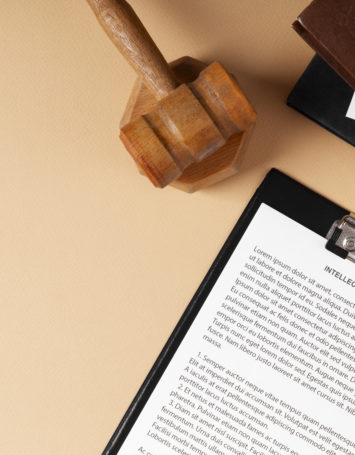Article by Clyde Shuman
The Patent Trial and Appeal Board of the U.S. Patent and Trademark Office has designated as informative two recent decisions applying the factors set forth in Apple Inc. v. Fintiv, Inc., IPR2020-00019, Paper 11 (PTAB Mar. 20, 2020) (precedential) (“Fintiv I,” and “the Fintiv factors”), for determining whether to institute an inter partes review (“IPR”) proceeding where a parallel district court action is pending. In Apple Inc. v. Fintiv, Inc., IPR2020-00019, Paper 15 (May 13, 2020) (informative) (“Fintiv II”), the Board denied Apple’s request to institute an IPR proceeding. In Sand Revolution II, LLC v. Continental Intermodal Group – Trucking LLC, IPR2019-01393, Paper 24 (June 16, 2020) (informative) (“Sand Revolution”), by contrast, the Board granted Sand Revolution’s request to institute an IPR. An examination of the two decisions may shed light on how the various Fintiv factors are applied and the heavily fact-specific nature of the analysis.
A. Fintiv II (denying instituting IPR)
In Fintiv II, Fintiv requested that the Board apply its discretion under 35 U.S.C. § 314(a) to deny instituting the requested IPR proceeding due to the advanced state of a parallel district court litigation in which the same issues had been presented and trial had been set for November 16, 2020.
The Board began by identifying the six Fintiv factors “that balance considerations of system efficiency, fairness, and patent quality when a patent owner raises an argument for discretionary denial due to the advanced state of a parallel proceeding”:
- whether the court granted a stay or evidence exists that one may be granted if a proceeding is instituted;
- proximity of the court’s trial date to the Board’s projected statutory deadline for a final written decision;
- investment in the parallel proceeding by the court and the parties;
- overlap between issues raised in the petition and in the parallel proceeding;
- whether the petitioner and the defendant in the parallel proceeding are the same party; and
- other circumstances that impact the Board’s exercise of discretion, including the merits.
Apple argued that, as an overall matter of policy, the Board should not deny instituting an IPR proceeding based on the state of a parallel district court proceeding. Per Apple, this “negates the statutorily provided one-year filing period, encourages forum shopping, improperly bases the decision on trial dates that are often moving targets, and contravenes Congressional intent of the America Invents Act, which was based on district courts granting stays.”
The Board discounted Apple’s arguments, noting that: (i) a parallel district court proceeding in an advanced state “implicates considerations of efficiency and fairness, which can serve as an independent reason to apply discretion to deny institution”; (ii) “it always has been the case that some district courts move faster than others, and patent owners seeking to enforce patents may be inclined to file suit in a district that moves relatively quickly”; and (iii) under certain circumstances, considerations of the state of a parallel proceeding “may require petitioners to act more quickly than the maximum amount of time permitted by Congress. Nonetheless, Congress also gave the Director discretion to deny institution.”
Turning to the Fintiv factors, the Board found:
- Factor 1: Neither party had requested a stay of the district court case pending The IPR proceeding. This factor did not weigh for or against discretionary denial in this case.
- Factor 2: The jury trial was set to begin on March 8, 2021, approximately two months before a final written decision would be due in the IPR proceeding. The Board said that it no reason to believe that the jointly agreed-upon trial date, already postponed by several months due to complications stemming from the COVID-19 pandemic, would be postponed again. Accordingly, this factor weighed somewhat in favor of discretionary denial in this case.
- Factor 3: The Board found that the parties each filed three Markman briefs in the district court, the court held a Markman hearing and issued a detailed 34-page claim construction order, and the parties had exchanged initial and final infringement and invalidity contentions, including claim charts addressing the prior art cited in Apple’s petition. However, fact discovery was in its early stages and substantive motion practice was yet to come. Accordingly, this factor weighed somewhat in favor of discretionary denial in this case.
- Factor 4: Apple admitted that the same claims were challenged in its IPR petition and in the district court, but argued that its invalidity contentions in district court contained more prior art. The Board said that Apple’s assertion of additional invalidity contentions in the district court was not relevant to the degree of overlap. That Apple had not decided whether to pursue the art from the IPR in the district court was not persuasive. The same art was presented in its final invalidity contentions. Thus, “because the identical claims are challenged based on the same prior art in both the [p]etition and in the [d]istrict [c]ourt, this factor weighs in favor of discretionary denial in this case.”
- Factor 5: Per the Board, “Because the petitioner and the defendant in the parallel proceeding are the same party, this factor weighs in favor of discretionary denial.”
- Factor 6: The Board the strengths of the merits did not outweigh other factors favoring discretionary denial. The Board expressly mentioned weaknesses in Apple’s IPR petition with respect to explaining how certain prior art invalidates various claims. Accordingly, “the merits, taken as a whole, do not tip the balance in favor of [Apple] and instead also weigh in favor discretionary denial in a balanced assessment of all the circumstances.”
The Board concluded that instituting IPR in these circumstances would not be an inefficient use of Board resources and denied institution under § 314(a).
B. Sand Revolution (instituting IPR)
In Sand Revolution, the Board originally denied institution of an IPR proceeding, reasoning that the case was controlled by its decision in NHK Spring Co., Ltd. v. Intri-Plex Techs., Inc., IPR2018-00752, Paper 8 (PTAB Sept. 12, 2018) (precedential) (“NHK”). Sand Revolution requested rehearing. The Board concluded that, in light of new evidence, the circumstances here were distinguishable from NHK and denial was not warranted under the Fintiv factors.
The Board originally denied instituting IPR because, as in NHK: (1) the related district court litigation involved the same parties as the IPR proceeding; (2) trial in the district court would begin before the Board’s final written decision was due; and (3) particular claim language was similarly interpreted in the district court and at the USPTO. Subsequent to the Board’s decision, Fintiv I issued. Given Sand Revolution’s claim that the district court’s trial schedule was uncertain and changing, the Board authorized additional briefing and evidence regarding the Fintiv factors. The Board found as follows:
- Factor 1: No stay had been requested or ordered in the related district court litigation. Per the Board, “we do not find that this factor weighs in favor of either exercising or not exercising discretion to deny institution under [ ] § 314(a).”
- Factor 2: The litigation trial date was uncertain. The patent owner identified that “the district court trial is scheduled to occur…at least five months…before any final decision from the Board would be due.” Since the original denial decision, the litigation schedule deadlines had been extended twice. After the parties’ supplemental briefing (April 13, 2020), the district court again amended its scheduling order, with the jury trial now scheduled to begin “February 8, 2021 (or as available).” The Board said, “[A]t this point it is unclear that the court in the related district court litigation will adhere to any currently scheduled jury trial date or, if it is changed, when such a trial will be held.” Accordingly, “this factor weighs marginally in favor of not exercising discretion to deny institution.”
- Factor 3: The Board agreed with Sand Revolution that that the district court and the parties had not invested substantially in the merits of the invalidity positions. The Board contrasted the circumstances in Fintiv II, cf. supra. Here, the parties had exchanged infringement and invalidity contentions and the district court had conducted a Markman hearing and entered a related Order, as well as amending the case schedule and denying a motion to dismiss. However, per the Board, “much of the district court’s investment relates to ancillary matters untethered to the validity issue itself.” And the district court’s two-page Markman order did not not demonstrate “the same high level of investment of time and resources as the detailed Markman Order in Fintiv [II].” Also, fact discovery was ongoing, expert reports were not yet due, and substantive motion practice was yet to come. As such, “this factor weighs only marginally, if at all, in favor of exercising discretion to deny institution.”
- Factor 4: The patent owner argued that the IPR and the district court litigation “involve[] the same patent, same claims, same invalidity references, and nearly identical invalidity arguments.” However, Sand Revolution argued that its district court invalidity contentions contained prior art references not at issue in the IPR, including several prior art systems in use or on sale during the relevant time period. Sand Revolution had stipulated that, if the IPR was instituted, it would not pursue the same grounds in the district court litigation. The Board found that Sand Revolution’s stipulation mitigated concerns of duplicative efforts, as well as of potentially conflicting decisions. “[T]his factor weighs marginally in favor of not exercising discretion to deny institution.”
- Factor 5: The parties were the same in the two proceedings. Per the Board, “this factor weighs in favor of discretionary denial.”
- Factor 6: The Board found that the balance of the other Fintiv factors weighed in Sand Revolution’s favor. The Board also found that Sand Revolution had met its burden of demonstrating a reasonable likelihood of prevailing on the merits of its petition. Per the Board, “[T]his factor weighs in favor of not exercising discretion to deny institution under [ ] § 314(a).”
The Board concluded, “Considering the Fintiv factors as part of a holistic analysis, we are not persuaded that the interests of the efficiency and integrity of the system would be best served by…deny[ing] institution of a potentially meritorious Petition.”
- Conclusion
Admittedly, two decisions is not much of a sample; however, this much seems clear. First, the Fintiv analysis is heavily fact-specific. Second, the following factors appear to be more significant than not in deciding whether to deny instituting an IPR: proximity of the district court’s trial date to the projected deadline for a final written decision (Factor 2); investment in the parallel district court proceeding by the court and the parties (Factor 3); overlap between issues raised in the petition and in the parallel district court proceeding (Factor 5); and relative merits of the IPR petition (Factor 6).
Additional Board decisions will be required to determine which Fintiv factor(s), if any, are to be considered more significant, if not dispositive.



